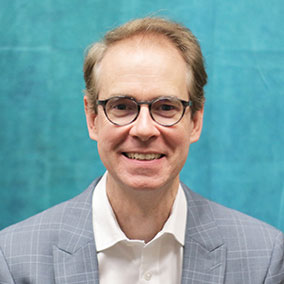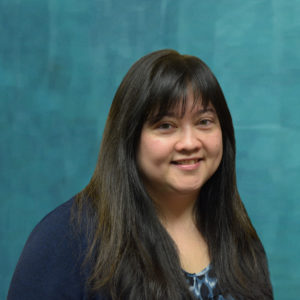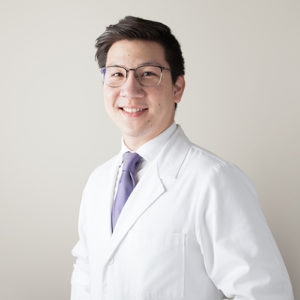sponsored content
June 1, 2022

One of few spectacle lenses available to slow the progression of myopia, SightGlass Vision’s novel Diffusion Optics Technology (DOT) spectacle lens, is currently only available in the Netherlands, and it is being piloted in other countries. DOT spectacle lenses are not currently marketed in the United States.
To find out how these new lenses have been received among young patients and their parents, Review of Myopia Management interviewed a group of Canadian optometrists who were among the pilot users – Kyriakos Mandadakis, Dr. K. Mandadakis and Associates, Toronto; Jeff and Tina Goodhew, Abbey Eye Care, Oakville, Ontario; and Theodore Chow, Chow Eye Institute, Markham, Ontario.
Thinking back to when you were first introduced to the DOT spectacle lens, what drove your initial interest in the product?
Dr. Kyriakos Mandadakis: I always like to incorporate new technology into my practice, whether retinal imaging or vision correction. Myopia control interested me, but I was hesitant about prescribing topical low-dose atropine. Also, contact lenses for many parents of children was a stress point. So, when the DOT spectacle lenses were introduced to me, it checked all the boxes regarding my concerns.
Dr. Jeff Goodhew and Dr. Tina Goodhew: We were intrigued by the fact that this novel lens design had a different mechanism of action from our current myopia control spectacles. We have been using peripheral defocus lenses and PAL-type lenses in our practice. Some children were well controlled, while others continued to progress faster than we would like. Having another spectacle lens option was exciting as it meant we might be able to help more children. The data released in the SightGlass Vision CYPRESS trial was compelling, showing a 59% reduction in SER over 24 months. More importantly, the clinical trial included children as young as 6 years of age, was multicentered, and included an ethnically diverse study population – similar to our own patient demographic.
 |
 |
Dr. Jeff Goodhew and Dr. Tina Goodhew
Dr. Theodore R. Chow: We first started using SightGlass in 2021. What drove our initial interest was the completely different mechanism of action. We practice in a large Asian community in the greater Toronto area with a very high prevalence of myopia, so we are a heavily specialized clinic in myopia management. Historically, that was orthokeratology lenses. We also offer multifocal soft contact lenses and the DIMS lens as our spectacle option.
The DOT lens is doing something completely different. Optically, the myopia control strategies already mentioned aim to create peripheral myopic defocus or increase higher-order aberrations centrally. The SightGlass DOT lens is entirely different. It works by changing the retinal contrast of the patient. That’s something brand new, and preliminary data have shown strong efficacy in controlling axial elongation and myopia in younger age groups. That was very encouraging and motivated us to try this new product.
What was the process you used to integrate DOT spectacle lenses into your practice?
Dr. Mandadakis: Every parent of a child who had any amount of myopia was educated on this new technology of lenses. A sample lens was shown to them, and the reaction was primarily positive. I believe parents and patients trust their eye doctor, and they know it takes a lot for me to get behind and promote a new treatment modality.
Drs. Goodhew: First, we researched the lens, and as the data was very compelling, we opted to bring the lens into our myopia management toolkit. We have every child who enrolls in our myopia management clinic complete a baseline exam from which we determine what the best method of treatment is for them. If we decide that it is myopia management spectacle lenses, we offer the option of using DOT spectacle lenses. Initially, we were concerned about the cosmesis of the lenses as they have a “fogged” appearance to them when held up to the light. However, the fogged appearance is hardly noticeable once placed in a frame and on the face. In fact, when we have a family where one child is wearing the DOT spectacle lens and the other is wearing a traditional single-vision lens, parents often do not note any difference between the appearances of the two sets of glasses once on the children.
Dr. Chow: We got in touch with the company when they were piloting these lenses in Canada. It was straightforward introducing it into our clinic. When we offer myopia management to our patients, mainly the very young children who are not too accepting of contact lens modalities, we tell the parent(s) and child that we have two spectacle lens options. One is the DIMS technology, and the other is the DOT technology. I then compare the pros and cons of each lens and describe the current research on the DIMS and the DOT lenses.
What is the current role of DOT spectacle lenses in your myopia management toolkit?
Dr. Mandadakis: I recommend and demonstrate the DOT lenses to every myopic child. I feel it is the standard of care to offer myopia control therapy to patients. Most myopic parents know that the progression is inevitable, as they have gone through it themselves. If something as simple as wearing glasses can help decrease the rate of progression and is safe, they are on board.
Drs. Goodhew: Spectacle lenses are a big part of our myopia management clinic as not every child can wear contact lenses, and many parents are not keen on pharmaceutical therapy. Furthermore, DOT spectacle lenses appear to work well with younger children. The more we can control myopia progression at this young age, the more significant the impact we can have.
Dr. Chow: Number one is it plays a more prominent role for my higher myopes. Because either their nearsightedness is so high or their astigmatism precludes them from using any other modality, that’s when I introduce the DOT spectacle lens for myopia control.
Number two is that some teenage patients (especially 12 to 14) are sensitive to visual blur. The benefit of the DOT lens is that it is gaze-independent. It doesn’t matter whether they’re looking straight at distance, six feet away, or on their phones. Their prescription is not changing, and they’re getting the same treatment effect. There are fewer complaints.
The DOT lens works by changing the contrast wherever you’re looking throughout the lens, so it should not be influenced by your working distance. There is a caveat to that. Because the DOT lens acts on reducing contrast, it looks a little frosted. Surprisingly, children adapt and do not complain. They quickly forget that there’s any frosting effect.
Are there any specific patient profiles for which you would consider DOT spectacle lenses first?

Dr. Kyriakos Mandadakis
Dr. Mandadakis: My comfort level is spectacles first. Having a proven technology that works (two years of data now) is an excellent addition to my practice. As stated previously, every myopic child is offered DOT lenses. Some parents are apprehensive about something that does not “look normal,” but most have embraced this new technology.
Drs. Goodhew: It is our lens of choice for our young myopes under 9 years. Also, DOT lenses come in an extensive parameter range, making them an easy choice for high amounts of myopia and/or astigmatism, and they are available in Transitions.1
Dr. Chow: Other than patients with high refractive error or high astigmatism that precludes them from other modalities, preliminary data for the DOT spectacle lens includes a 6- to 8-year-old group who might not work well with contact lenses and need spectacles. It’s nice to have reports on efficacy specifically targeting this age group and see that the effectiveness is consistent.
When presenting DOT spectacle lenses to parents/patients, can you walk us through the conversation and the parental/child reactions to the product?
Dr. Mandadakis: At the completion of the examination, confirmation is made that the child has developed myopia or that their myopia has progressed. Before DOT lenses, the conversation was about atropine or contact lenses. I would inform the parents that I did not feel comfortable prescribing atropine for their child to use daily and that I could refer them to someone who did. The majority chose not to be referred. Now with the DOT lenses, the concept is introduced, and the lenses are demonstrated to show that the decrease in contrast is not a big issue. Most parents comment on how the glasses look better than their child’s dirty glasses. Also, I share the DOT two-year data, and I add that in the worst-case scenario, myopia progresses. This falls in line with “do no harm.”
Drs. Goodhew: We tell parents that several myopia management spectacle lenses are available, with the DOT spectacle lenses being among the most effective. Studies show a >50% reduction in myopia progression with these lenses. We then explain that the lenses work by reducing retinal contrast signaling. They have a small clear central zone with a light-scattering zone in the periphery. The lenses do have a fogged look to them, but we do not point that out to parents. Instead, we put a demo frame on the child with the DOT lenses and let the parent make observations. The fogged appearance is barely noticeable once the lenses are on the child’s face.
Dr. Chow: I explain that there are currently three different spectacle lenses to control myopia progression, and they work on entirely different mechanisms of action.
If this patient had previously never worn any myopia control product, I show them the lenses. I put both sample lenses on my eye and say, “As you can see, when it’s on my face, you can’t notice any major difference between these special myopia-controlling lenses and the standard single-vision lenses you’re used to.”

Dr. Theodore Chow
Then I take them off and give them to the parent and the child so they can switch. I tell them they will adapt quickly and then explain the different mechanisms of action.
Many Chinese patients are familiar with OrthoK lenses, so I tell them that is one method – the traditional method of controlling myopia progression – and DOT lenses are a novel method that is also efficacious but completely different. If they’re coming from another myopia control modality and it’s not working, then I immediately tell them that this is a completely novel mechanism that we can try.
I can’t promise it’s any better than their current modality, but it’s certainly something novel that we could try as long as the child can adapt to the lens design. It is evidence-based, and it won’t harm them.
I let them choose because my main priority is for the child. I tell them that the lenses need to be worn for at least ten hours a day; the longer, the better. I want the child to be able to wear them as much as possible.
How long have you been prescribing DOT spectacle lenses, and what has been your experience with the product performance to date?
Dr. Mandadakis: I am happy and proud to say that I am account 001 (although 007 would have been fine as I am a huge James Bond fan [laughs]). My experience with prescribing the DOT lenses has been great. Working with SightGlass Vision has been easy. There have been no issues with children adapting to the lenses and using them.
Drs. Goodhew: We’ve been using DOT lenses since August 2021 and have just had our first batch of children through for their six-month follow-ups. We’ve been impressed by the efficacy of this novel lens design so far.
We have an interesting story of a family with two identical 8-year-old twin girls. In 2021, we put one child in the DOT spectacle lenses, and the other child in peripheral defocus lenses. At the six-month mark, the child in the DOT lenses had progressed half as much as her twin in both refraction and axial length. This is an N of 1, but we were very encouraged by the results.
We welcome any new lens technology that allows us to manage myopia in our younger patients better. DOT spectacle lenses are a welcome addition to our myopia management tool kit.
Dr. Chow: We’ve been using the DOT lenses for about six months. Our experience has been great. There was some initial hesitation with the frosted appearance of the lens. However, adaptation was surprisingly strong. In terms of efficacy, the majority of my patients’ axial elongation was well controlled at the six-month point. A select few had a little bit of a hyperopic shift. We see this in OrthoK and MiSight contact lenses as well.
It remains to be seen how effective it will be in the long term compared with all my other myopia control modalities. Still, when we have such a range in individual preferences and whether they’re looking for spectacles versus contact lenses, it’s nice to have a novel lens in the market that slows myopia progression in most users.
References
1 Transition only available in some markets.













